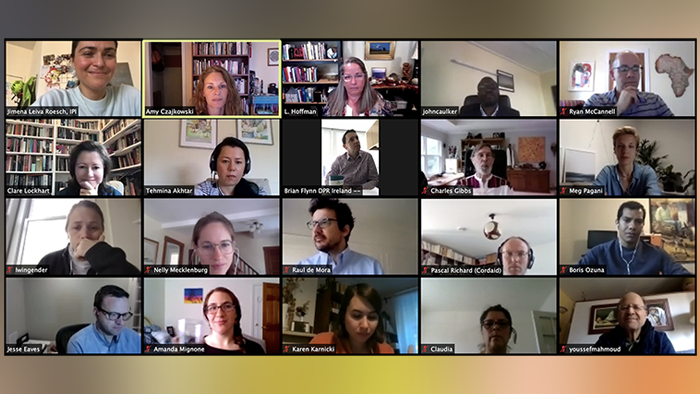
Global funding flows are critical to the success of community-centered peace and development. Local leaders often perceive complex international funding mechanisms as barriers to their work, and as ignoring or undervaluing their leadership. As a result, a great deal of potential for communities to create peace and development initiatives remains untapped.
IPI and Catalyst for Peace (CFP) co-hosted a May 21st virtual discussion on the ways global funding systems can support community-led action. The online panel and discussion, “Funding and Design for Local Ownership: What Helps? What Hurts?” was an open, inclusive, and transparent discussion among different stakeholders in the global funding system. Participants engaged in an imaginative conversation about how national and international funding mechanisms can better support the emergence of strong, inclusive communities that are able to resolve conflicts and come together around clear priorities.
Participants also addressed how funders can support community leadership in response to the global pandemic. Speakers shared specific examples from their work that demonstrated inclusive funding design. They also spoke on specific challenges that inhibited local leadership and community engagement.
Some of the key lessons mentioned:
The value of local ownership and innate community resources
- It is critical to ensure communities are the drivers of change. International partners must help create systems that support community ownership and leadership in sustainable development.
- Funding the community is sometimes treated as “overhead,” something to minimize, when really it is the investment that needs to be made.
- A school in a community built by outside contractors collapsed: the lesson the contractors learned was to involve the community in any new projects.
- In one country, an impeccable financial audit of funding revealed very few traces of misuse of funds from a locally-owned sustainable development project. When mechanisms are created for community ownership and dialogue with local officials, they feel ownership and accountability. The community members were watching and monitoring how the money was spent.
- In another country, villages were capable of doing themselves at a fraction of the cost what big contractors could do.
- What is needed: a process of consultation—go and ask communities what to do, what they need, then they will be able to say this project is theirs. Outside funders or organizations should not do anything without involvement and leadership from the community.
Making funding systems effective
- Funding is usually based on needs assessment, calculating what is not there, so the funder can bring it in. It is imperative, though, to understand the strengths, resources, and assets that the community can bring to the task.
- Despite the pressures of COVID-19, there is an abundance of funding. Funders everywhere are looking for good projects to invest in. What is missing is the design work that connects that funding to the right local processes and systems. Investment needs to be made into building financial and accounting piping that connects funding activities to work that needs to be done.
- The top-down funding approach is less aware of the community needs. The solutions need to be locally owned. When the whole system is visible as nested, connected layers, there is no top down or bottom up funding flows. Peace is built from the inside out.
- Aid from the international community is often given to solve problems, and more is given when those problems are not solved. Financial aid alone will not be effective if it is poured endlessly into a broken system. Work to repair and strengthen local systems that are under stress can help.
Funding challenges and what comes next
- What does not work is fragmentation and questioning whether the community should be at the center.
- There is a tension between effective practice the constraints of For many practitioners, supporting local organizations is the most sustainable and responsible practice. For big bureaucracy, their responsibility is pushing money by the end of the fiscal year, so lots of shortcuts and mistakes happen.
- The peacebuilding community can get caught up in its own language and it sounds incomprehensible to others that are looking at the same things and using different language to solve those same problems.
- The UN’s attitude can be top-down. Every year they hold a women and youth open call, with standards so high that local peacebuilders can never reach the requirements, and until these procedures are reviewed, the piping of the funds will never work. Member states and those who contribute to the peacebuilding fund must lead this. If they say they want to shift powers to change agency, to listen to locals, it will happen.
IPI and CFP aim to build on these conversations, especially best practices for funders and how different parts of the system (organizations, government, and funders) can work together to center local, community leadership.







